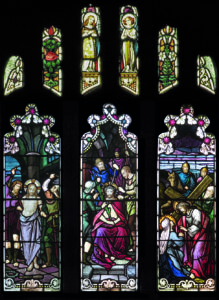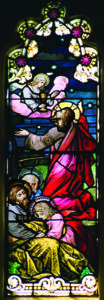Sorrowful Mysteries in Stained Glass
In the Mary C hapel of St Mary of the Angels, Wellington, are three sets of windows portraying the Mysteries of the Rosary. The left set contain the Joyful Mysteries (see September 2020 issue) and the first Sorrowful Mystery. The right set has the Glorious Mysteries (see October 2020 issue) and the last Sorrowful Mystery. The central set (right) contains the middle three Sorrowful Mysteries. There is a certain symmetry in the arrangement as the windows work their way through the Joyful, Sorrowful and Glorious Mysteries of the Rosary from left to right.
hapel of St Mary of the Angels, Wellington, are three sets of windows portraying the Mysteries of the Rosary. The left set contain the Joyful Mysteries (see September 2020 issue) and the first Sorrowful Mystery. The right set has the Glorious Mysteries (see October 2020 issue) and the last Sorrowful Mystery. The central set (right) contains the middle three Sorrowful Mysteries. There is a certain symmetry in the arrangement as the windows work their way through the Joyful, Sorrowful and Glorious Mysteries of the Rosary from left to right.
The First Sorrowful Mystery is the Agony in the Garden. Jesus led the disciples to Gethsemane and went into the garden with Peter and two other disciples. He made His famous plea “My Father, if it is possible, let this cup pass from me; yet not what I want but what you want.” He told the disciples to stay awake, but three times went back and found them sleeping
 The scene is shown beautifully in the window [2]-- Jesus praying the cup should pass him by, the disciples asleep behind him.
The scene is shown beautifully in the window [2]-- Jesus praying the cup should pass him by, the disciples asleep behind him.
When I reflect on how this mystery might apply to me, I can’t help thinking about the times I have been oblivious to the Lord and I am sorry. Does the ‘Sorrowful’ title refer to Jesus’ sorrow, or our own? I suppose that’s part of the reason it is a Mystery.
The second and third Sorrowful Mysteries are the Scourging at the Pillar [3] and Crowning with Thorns [4]. According to Mark’s account, Pilate ordered Jesus to be scourged and handed him over to be crucified.
Presumably after he had been scourged, they first dressed him in a purple cloak and crowned him with thorns, then they beat him about the head, stripped him and put his own clothes on him. Jesus went through a great deal of pain and humiliation at the hands of Pilate’s soldiers, and all for our sake.
I think of the martyrs who have endured similar mockery, pain and humiliation for the sake of their faith in Jesus, and I feel very humble, and at the same time glad that I live in a peaceful country. But I also think of the times I might not have stood up for my faith as Jesus would have wished me to. That he forgives me is a sorrowful mystery.
When I meditate on the Fourth Sorrowful Mystery as depicted in the window [5], I can’t help but think how little of Jesus’ walk with the cross it portrays.
I have written a number of dramatisations of the Stations of the Cross. Jesus fell three times. He met his Mother Mary. He met the women of Jerusalem. His face was wiped by Veronica. In the window, he could almost be in the act of falling. The woman is Mary, but could represent the other women and Veronica.
Simon of Cyrene helped Jesus carry His cross, and there he is behind Jesus. The soldiers are in the background, although the horse doesn’t seem right - I always imagined that the Roman soldiers would have been on foot.
The mystery to me is how Jesus managed to make the journey from the palace to the top of Calvary. It’s not called the Way of the Cross for nothing. He fell and picked himself up three times. By the time he got to the top of the hill he must have been exhausted.
I suppose that forms a model for us - how to take up our crosses, whatever they may be, and to carry them through life as we follow Jesus. That we can carry our crosses with the strength he gives us because of his sacrifice is just one more sorrowful mystery.
Finally, we have the fifth Sorrowful Mystery, the Crucifixion and Death of Our Lord [6]. Of all the crucifixion depictions I have seen, this ranks as one of the most poignant. The strain on Jesus’ body is so very evident. The soldiers had already taken his clothes and tossed the dice for the seamless undergarment.
The sky is dark, so I imagine the artist wanted to portray the time when Jesus was almost ready to give up his spirit. In John’s account, when Jesus saw his Mother and the disciple he loved (John himself) nearby, he declared them as mother and son. They are depicted beautifully in the window.
As I meditate on this Mystery, I have so many things to think about. Jesus, in a sense, declared Mary to be the Mother of the Church. There is nothing sorrowful about that! Yet Jesus giving up his life for me is like a ‘Good News, Bad News’ moment. The bad news is that Jesus had to die, the good news is that he did it to give me new life in him. Paul wrote (Romans 5:17) that death ruled through the fault of one man (Adam), so we receive the free gift of life through one man, Jesus Christ.
That’s a mystery, sorrowful because Jesus made the sacrifice freely, but I can’t help feeling joyful because he saved me and gave me new life. When I think back to the time before I knew Jesus, I realise that I was not worth knowing. Now I am a new man every day. Thank Jesus!




 Entries(RSS)
Entries(RSS)